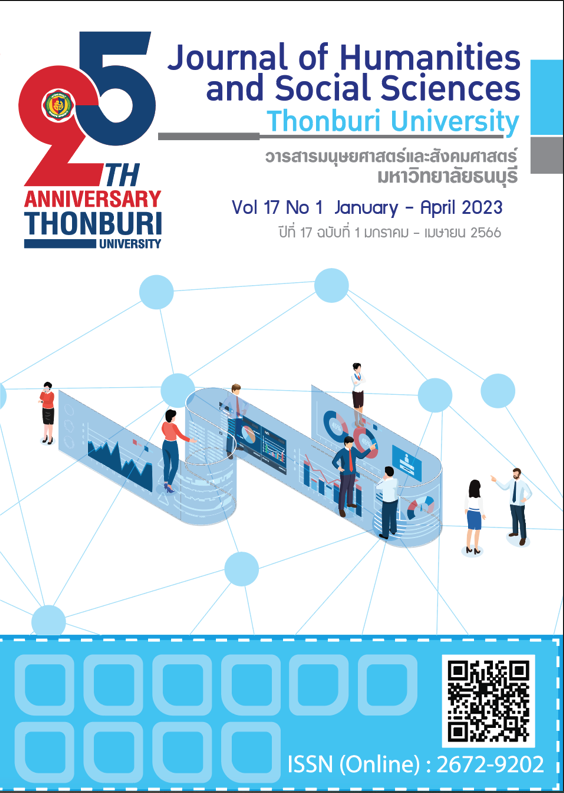The Structural Equation Model of causal factor influencing attitudes for using self-checkout machine in modern trade in Bangkok
Keywords:
Technology Acceptance, Self-checkout machine, Modern tradeAbstract
The purposes of this research were to study 1) Develop the model of perception of technology acceptance and attitude toward using self-checkout machines (SCM), 2) Examine the coherence of the technology adoption model and shoppers' attitudes towards use of SCM with empirical data and 3) To study the causal factors between technology acceptance and SCM in modern trade in Bangkok. Questionnaire was used a research tool, 450 samples of consumers SCM were collected. The path analysis was used to test the hypotheses. The Structural equation modeling: SEM was used to test the causal factors between technology acceptance and attitudes toward using SCM in modern trade in Bangkok. The results showed the causal relationship of the SEM was created consistently with the empirical data and had the ability to predict at a good level and at the level of acceptance of 64 percent. According to the causal relationship were found innovation factors, perceived stimulus, perceived ease of use directly and indirectly effect related through perceived usefulness. For the subjective norm factor, there were an indirect effect through perceived ease use and perceived usefulness. Finally, was found the direct effect of the perceived usefulness factor and the attitude of SCM among shoppers in modern trade in Bangkok at the statistically significant level 0.05.
References
Administrative Strategy Division. (2020). Population in Bangkok. Retrieve 6 August 2020, from https://webportal.bangkok.go.th/pipd/page/sub/16647/Bangkok statistics-2019.
Aheadasia (2020). Get to know 5 retail technology trends for 2020. Retrieve 8 November 2021, From https://ahead.asia/2020/01/09/5-tech-trends-for-retail-in-2020/
Bandura, A. (1977). Self-efficacy: Toward a unifying theory of behavioral change. Psychological Review, 84(2), 191–215. https://doi.org/10.1037/0033-295X.84.2.191.
Blut, M., Wang, C. & Schoefer, K. (2016). Factors influencing the acceptance of self-service technologies: a meta-analysis. Journal of Service Research, 19(4), 396–416.
Bollen, K. A. (1989). Structural equations with latent variables. John Wiley & Sons. from https://doi.org/10.1002/9781 118619179
Bot (2021). Open 4 world trends New Normal. Retrieve 27 January 2022, from https://www.bot.or.th/Thai/BOTMagazine/Pages/256402CoverStory.aspx
Bulmer, S., Elms, J., & Moore, S. (2018). Exploring the adoption of self-service checkouts and the associated social obligations of shopping practices. Journal of Retailing and Consumer Services, 42, 107–116.
Chen, M.-F. & Lin, N.-P. (2018). Incorporation of health consciousness into the technology readiness and acceptance model to predict app download and usage intentions. Internet Research, 28(2), 351-373.
Chen, S.C., Chen, H.H., & Chen, M.F. (2009). Determinants of satisfaction and continuance intention towards self-service technologies. Industrial Management and Data Systems, 109(9), 1248-1263.
Considine, E., & Cormican, K. (2016). Self-service technology adoption: An analysis of customer to technology interactions. Procedia Computer Science, 100, 103–109.
Fernandes,T. & Pedroso, R. (2017). The effect of self-checkout quality on customer satisfaction and repatronage in a retail context. Service Business ,11(1), DOI: 10.1007/s11628-016-0302-9.
Ferreira, J.B., da Rocha, A., & da Silva, J.F. (2014). Impacts of technology readiness on emotions and cognition in Brazil. Journal of Business Research, 67(5).865-873.
Fishbein, M., & Ajzen, I. (1975). Belief, attitude, intentions and behaviour: An introduction to theory and research. Boston, MA: Addison-Wesley.
Hair, J. F., Jr., Black, W. C., Babin, B. J., Anderson, R. E., & Tatham, R. L. (2010). Multivariate data analysis. 7th ed. New Jersey: Pearson Prentice Hall.
Jeong, S.C., Kim, S.H., Park, J.Y. & Choi, B. (2017). Domain-specific innovativeness and new product adoption: a case of wearable devices, Telematics and Informatics, 34(5), 399-412.
Kallweit, K., Spreer, P. & Toporowski, W. (2014). Why do customers use self-service information technologies in retail? The mediating effect of perceived service quality. Journal of Retailing and Consumer Services. 21(3), 268-276.
Kline, P. (1994). An Easy Guide to Factor Analysis. Psychology Press.
Krungsri (2021). Wholesale&Retail Trade Value 2564-2566: Modern Trade. Retrieve 3 February 2021, From https://www.krungsri.com/th/research/industry/industry-outlook/wholesale-retail/modern-trade/io/io-modern-trade-21
Rogers, E.M. (2003). Diffusion of Innovations. 5th ed. New York: Free Press A Division of Simon & Schuster, Inc.
Schumacker, R.E. , & Lomax, R.G. (2004). A Beginner's Guide to Structural Equation Modeling. Mahwah, NJ: Lawrence Erlbaum Associates.
Wang, M.C.H. (2012). Determinants and consequences of consumer satisfaction with self-service technology in a retail setting. Managing Service Quality, 22(2), 128-144.
Downloads
Published
How to Cite
Issue
Section
License
Copyright (c) 2022 พีรภาว์ ทวีสุข

This work is licensed under a Creative Commons Attribution-NonCommercial-NoDerivatives 4.0 International License.
ผลงานที่ปรากฎในวารสารฉบับนี้เป็นลิขสิทธิ์เฉพาะส่วนบุคคลของผู้เขียนซึ่งต้องรับผิดชอบต่อผลทาง กฎหมายที่อาจเกิดขึ้นได้และไม่มีผลต่อกองบรรณาธิการ






